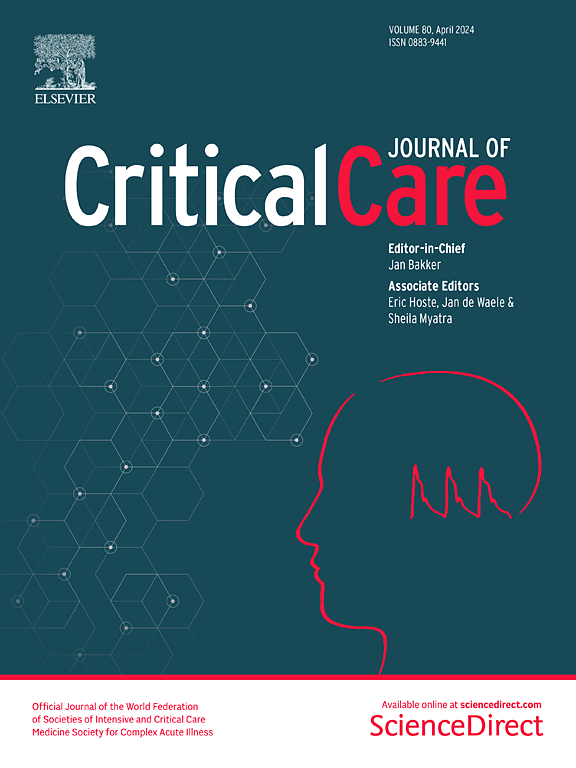急性呼吸窘迫综合征的气道上皮损伤
IF 8.8
1区 医学
Q1 CRITICAL CARE MEDICINE
引用次数: 0
摘要
气道上皮(AE)在维持肺稳态方面发挥着多种功能,其中包括确保充分的屏障功能、细胞分化和极化,以及通过聚合免疫球蛋白受体(pIgR)积极转运气道腔内主要的粘膜免疫球蛋白--免疫球蛋白 A(IgA)。ARDS 的气道形态变化已有报道,但其具体特征、对粘膜免疫的影响以及致病机制仍不清楚。因此,本研究旨在评估 ARDS 患者远端气道上皮的改变。我们回顾性地分析了 ARDS 患者和对照组的肺组织样本,采用多重荧光免疫染色法和计算机辅助全组织切片定量法对小气道的结构和功能变化进行了研究和定量。此外,我们还测量了前瞻性收集的 ARDS 患者和对照组血清和支气管肺泡灌洗液(BALF)中的粘膜免疫标记物 IgA 和 pIgR 以及其他上皮标记物。与对照组相比,ARDS 患者的气道上皮变性增加(p = 0.0003),中性粒细胞弥漫性上皮浸润(p = 0.0005)。多重荧光免疫染色的定量评估显示,纤毛细胞减少(p = 0.0317),鹅口疮细胞有减少的趋势(p = 0.056),而细胞祖细胞(基底细胞和俱乐部细胞)没有变化,这表明粘膜分化发生了改变。ARDS 还显示上皮通透性增加,紧密连接蛋白(p < 0.0001)和粘连蛋白(p = 0.025)显著减少。此外,我们还观察到 pIgR 的表达明显下降(p < 0.0001),这表明粘膜 IgA 免疫功能受损。在 ARDS 中,血清中的分泌成分(SC)和 S-IgA 浓度与其他肺源性蛋白(CC16、SP-D、sRAGE)一起增加(p 均 < 0.0001)。然而,它们在 BALF 中的浓度保持不变,这表明气道和肺泡蛋白通过受损的 AE 外溢。ARDS 患者的气道上皮表现出多方面的改变,导致粘膜分化改变、防御功能受损和渗透性增加,并伴有肺蛋白血症。本文章由计算机程序翻译,如有差异,请以英文原文为准。
Airway epithelium damage in acute respiratory distress syndrome
The airway epithelium (AE) fulfils multiple functions to maintain pulmonary homeostasis, among which ensuring adequate barrier function, cell differentiation and polarization, and actively transporting immunoglobulin A (IgA), the predominant mucosal immunoglobulin in the airway lumen, via the polymeric immunoglobulin receptor (pIgR). Morphological changes of the airways have been reported in ARDS, while their detailed features, impact for mucosal immunity, and causative mechanisms remain unclear. Therefore, this study aimed to assess epithelial alterations in the distal airways of patients with ARDS. We retrospectively analyzed lung tissue samples from ARDS patients and controls to investigate and quantify structural and functional changes in the small airways, using multiplex fluorescence immunostaining and computer-assisted quantification on whole tissue sections. Additionally, we measured markers of mucosal immunity, IgA and pIgR, alongside with other epithelial markers, in the serum and the broncho-alveolar lavage fluid (BALF) prospectively collected from ARDS patients and controls. Compared to controls, airways of ARDS were characterized by increased epithelial denudation (p = 0.0003) and diffuse epithelial infiltration by neutrophils (p = 0.0005). Quantitative evaluation of multiplex fluorescence immunostaining revealed a loss of ciliated cells (p = 0.0317) a trend towards decreased goblet cells (p = 0.056), and no change regarding cell progenitors (basal and club cells), indicating altered mucociliary differentiation. Increased epithelial permeability was also shown in ARDS with a significant decrease of tight (p < 0.0001) and adherens (p = 0.025) junctional proteins. Additionally, we observed a significant decrease of the expression of pIgR, (p < 0.0001), indicating impaired mucosal IgA immunity. Serum concentrations of secretory component (SC) and S-IgA were increased in ARDS (both p < 0.0001), along other lung-derived proteins (CC16, SP-D, sRAGE). However, their BALF concentrations remained unchanged, suggesting a spillover of airway and alveolar proteins through a damaged AE. The airway epithelium from patients with ARDS exhibits multifaceted alterations leading to altered mucociliary differentiation, compromised defense functions and increased permeability with pneumoproteinemia.
求助全文
通过发布文献求助,成功后即可免费获取论文全文。
去求助
来源期刊

Critical Care
医学-危重病医学
CiteScore
20.60
自引率
3.30%
发文量
348
审稿时长
1.5 months
期刊介绍:
Critical Care is an esteemed international medical journal that undergoes a rigorous peer-review process to maintain its high quality standards. Its primary objective is to enhance the healthcare services offered to critically ill patients. To achieve this, the journal focuses on gathering, exchanging, disseminating, and endorsing evidence-based information that is highly relevant to intensivists. By doing so, Critical Care seeks to provide a thorough and inclusive examination of the intensive care field.
 求助内容:
求助内容: 应助结果提醒方式:
应助结果提醒方式:


